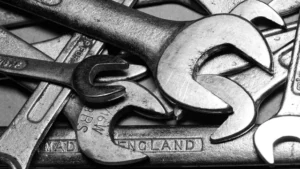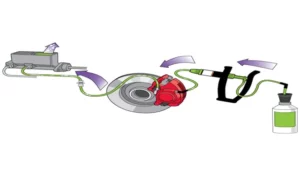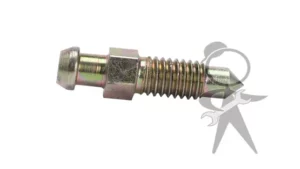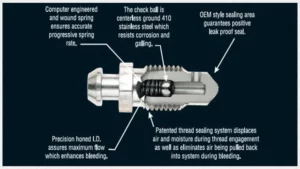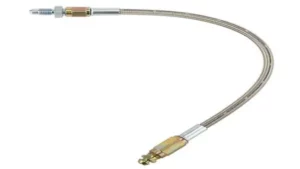Brake bleeder screws are small but essential components needed for effective brake maintenance. They are necessary for bleeding the brake system and ensuring that your brakes are in good condition. However, the screws can become stripped over time due to rust or overtightening, making them difficult to remove.
If you find yourself in this situation, don’t panic. There are several methods you can use to remove a stripped brake bleeder screw without causing further damage. In this blog post, we will discuss the steps you can take to remove a stripped brake bleeder screw and get your brake system back in order.
So sit back and relax as we take you through the process step by step.
Introduction
If you’re working on your car and come across a stripped brake bleeder screw, don’t panic – it’s a common problem that can be fixed. The first thing you can try is using a pair of vice grips to grab hold of the screw and twist it out. If that doesn’t work, you can use a screw extractor kit to drill into the center of the screw and remove it that way.
However, be careful not to damage the surrounding parts when drilling. Another option is to use a specialized tool called a left-hand drill bit, which is designed to turn the screw counterclockwise as it drills. This method can be risky, so it’s best to leave it to experienced mechanics.
Overall, removing a stripped brake bleeder screw can be a frustrating task, but with some patience and the right tools, it can be done.
Explaining the Importance of Brake Bleeder Screws
Brake bleeder screws are an important component of your vehicle’s braking system. These tiny screws are responsible for removing any air and moisture from the brake lines, which ensures that your brakes always work efficiently. Although they may seem insignificant, brake bleeder screws play a crucial role in maintaining the safety of your vehicle.
Without them, air bubbles can accumulate and reduce the effectiveness of your brakes. If you are experiencing brake problems and have ruled out the brake pads and calipers, it’s important to check the brake bleeder screws as they may be clogged or rusted and need replacing. Taking care of your brake bleeder screws is an essential part of preventative maintenance and can ultimately save you time, money, and perhaps even your life.
So, make sure to keep an eye on them during your regular vehicle checks and always replace them if they become damaged or corroded.
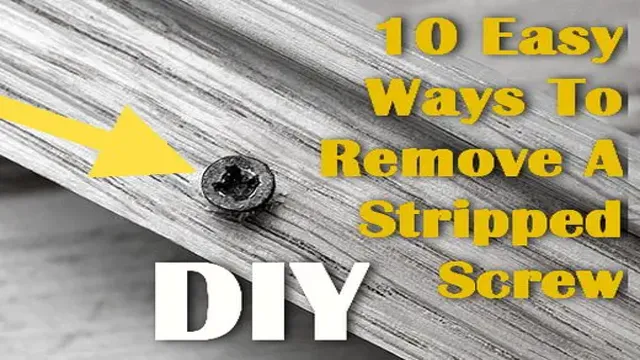
Possible Causes of Stripped Brake Bleeder Screws
Introduction A stripped brake bleeder screw can be a common issue that causes a lot of frustration. This problem happens when the threads on the screw become worn and damaged, making it impossible to remove the screw safely. There are several possible causes of this issue, from corrosion to over-tightening, that can lead to the stripped screw.
If you are dealing with this problem, it’s essential to get it fixed quickly, as it can compromise the safety and performance of your braking system. In this blog section, we’ll explore the possible causes of stripped brake bleeder screws and what you can do to prevent this issue from happening. By understanding the causes, you can take the necessary steps to keep your brakes working correctly and safely.
Tools needed to Remove a Stripped Brake Bleeder Screw
Removing a stripped brake bleeder screw can be a challenging task, but having the right tools can make all the difference. One of the most effective tools for removing a stripped brake bleeder screw is a screw extractor. This tool is designed specifically for removing stripped screws and can easily grip and extract the screw without damaging the surrounding materials.
Another useful tool is a left-hand drill bit, which can help to loosen the screw by turning it counterclockwise. A set of easy-outs, which are essentially reverse drill bits, can also be useful in removing a stripped screw. Finally, a pair of locking pliers can be used to get a better grip on the screw, while a penetrating oil can be used to help loosen it up before attempting to remove it.
By having the right tools on hand, you can make the process of removing a stripped brake bleeder screw much easier and more successful.
Listing the Necessary Tools for the Job
Removing a stripped brake bleeder screw can be a daunting task, but with the right tools, it can be done with ease. The necessary tools needed for the job include a pair of vice grips, a penetrating oil, a drill, a left-handed drill bit, an easy out tool, and a wrench. To begin, apply the penetrating oil around the screw and let it sit for a few minutes to help loosen the rust and corrosion.
Using a pair of vice grips, try to turn the screw counterclockwise to unscrew it. If that does not work, drill a small hole in the center of the screw with a left-handed drill bit. The left-handed drill bit will cause the screw to turn counterclockwise as it drills, which can help loosen it.
If the screw still refuses to budge, use an easy out tool to remove it. An easy out tool is designed to grip the screw and turn it counterclockwise as you apply force to it. Finally, use a wrench to remove the remaining parts of the screw and replace it with a new brake bleeder screw.
Tips for Proper Tool Handling
When it comes to removing a stripped brake bleeder screw, having the right tools is essential. First and foremost, you’ll need a pair of vice grips or pliers to grip onto the screw tightly. A penetrating oil can also help loosen up any rust or debris, making it easier to turn the screw.
An extractor kit can also be extremely useful in these situations, as it has specialized bits designed to grip onto stripped bolts or screws and turn them with ease. Alternatively, if you’re in a pinch, you can try using a rubber band to grip onto the screw and turn it. Just place the rubber band over the screw head and use a screwdriver to turn it.
With the right tools and a little bit of patience, even the most stubborn stripped brake bleeder screw can be removed successfully.
Step by Step Guide to Remove a Stripped Brake Bleeder Screw
Removing a stripped brake bleeder screw can be a daunting task, but with the right tools and approach, it’s possible to get it done. Start by spraying penetrating oil on the screw, and let it sit for a few minutes to loosen any rust or debris. Then, use a pair of locking pliers to grip the screw and apply steady pressure as you turn it counterclockwise.
If that doesn’t work, try using a stripped screw extractor tool, which works by gripping the screw from the inside and turning it out. It’s important to be patient and gentle while working on the screw, as too much force can cause the screw to break or damage the surrounding parts. With a little persistence and the right tools, you can remove a stripped brake bleeder screw and get your brakes back in working order.
Prepare the Area and Get Started
Before you start removing a stripped brake bleeder screw, it’s essential to prepare the area properly. The last thing you want is to cause damage to the surrounding components or strip the screw even further. So, begin by cleaning the area around the bleeder screw, removing any dust, debris, or rust buildup.
Next, use a wire brush to remove any stubborn debris. Then, spray penetrating oil around the base of the screw and give it some time to work its magic. Once the oil has had a chance to penetrate the screw, take a wrench that fits the screw snugly, and try turning it gently.
If it turns, great! But, if it doesn’t, don’t worry. You can still remove the screw by following the next steps. The key here is to take it slow and be patient, or you might end up making matters worse.
Heat the Area and Use a Hammer
If you’re dealing with a stripped brake bleeder screw, it can be frustrating to say the least. Not only is it difficult to remove, but it’s also essential for proper brake function. But fear not, as there’s a step-by-step guide to help you remove it.
First, you’ll want to heat the surrounding area with a heat gun. This will cause the metal to expand and make it easier to turn the screw. Next, use a hammer and tap it lightly to try and break the seal.
If it still won’t budge, you can try using a screw extractor tool. The important thing is to not apply too much force, as this could damage the brake line and lead to expensive repairs. With patience and persistence, you can successfully remove a stripped brake bleeder screw and get back to smooth, reliable braking.
Use a Vise Grip and Extract the Screw
A stripped brake bleeder screw can be a frustrating issue to deal with and can cause problems when it comes to bleeding the brakes on your vehicle. However, there is a solution to this problem, and that is using a vise grip to extract the screw. Here’s a step-by-step guide on how to do it.
First, you need to make sure you have the right tools for the job. You will need a vise grip, penetrating oil, and a wrench that fits the bleeder screw. Next, spray the penetrating oil on the bleeder screw and let it sit for a few minutes to penetrate the threads.
Then, use the wrench to try and loosen the screw, but be careful not to damage it further. If the wrench is not effective, take the vise grip and use it to clamp onto the screw head. Tighten the vise grip until it has a firm grip on the screw, making sure not to damage the surrounding parts.
Once you have a good grip, turn the vise grip counterclockwise, and the screw should start to loosen. If you encounter resistance or the screw is still not budging, you can try applying heat to the area around the screw, which will expand the metal and loosen any corrosion. Alternatively, you could try tapping the surrounding area with a hammer to help loosen the screw’s grip.
In conclusion, a stripped bleeder screw may seem like an insurmountable problem, but it can be fixed with a little patience and the right tools. By following this step-by-step guide and using a vise grip to extract the screw, you can get your brakes functioning correctly again. Don’t forget to properly bleed the brakes after replacing the bleeder screw to ensure your vehicle’s safety.
Preventing Future Stripped Brake Bleeder Screws
If you want to prevent stripped brake bleeder screws in the future, there are a few things you can do. First, make sure you are using the correct size wrench and don’t overtighten the screw. It’s also a good idea to lubricate the threads with some penetrating oil before attempting to remove the screw.
Additionally, consider investing in a quality set of brake bleeder wrenches that provide a better grip and reduce the risk of stripping. Another option is to use a specialized tool called a screw extractor to remove the stripped screw without causing further damage. By taking these precautions and using the right tools, you can save yourself time and frustration while keeping your brakes in top condition.
Remember, prevention is key!
Tips to Keep Brake Bleeder Screws from Stripping
If you’re a DIY mechanic or frequently work on cars, you know how frustrating it is to deal with stripped brake bleeder screws. Not only does it slow down the process, but it can also cost you a lot of money in repairs. To prevent future stripped brake bleeder screws, there are a few tips you can keep in mind.
Firstly, always use the correct size and type of wrench to turn the screw. Using the wrong tool can result in the screw getting damaged. Secondly, apply penetrating oil to the bleed valve a day before starting any repair work.
This will make the screw much easier to turn. Finally, if you’re dealing with an old and rusty valve, it’s best to replace it entirely. You can also invest in a high-quality brake bleeder kit that comes with adjustable wrenches, hoses, and a vacuum pump.
With these tips under your belt, you can ensure that you won’t have to deal with stripped brake bleeder screws again.
Conclusion
When life gives you a stripped brake bleeder screw, don’t panic! You have a few options. You can use pliers or vise grips to try and unscrew it. You can use heat to loosen it up.
You can even drill it out if necessary. Whatever you do, make sure to stay calm and take your time. And next time, make sure to use a torque wrench and properly lubricate the threads to avoid this sticky situation altogether.
Happy braking!”
FAQs
What is a brake bleeder screw and why is it important?
A brake bleeder screw is a small valve located on the brake caliper or wheel cylinder that allows air to escape from the braking system during bleeding, ensuring proper brake function. It is important because air in the braking system can cause a loss of brake pressure and reduced braking performance.
How can I tell if my brake bleeder screws are stripped?
If your brake bleeder screws are stripped, you may experience difficulty opening or closing them with a wrench or pliers, or notice that they are rounded or damaged. This can also cause air to enter the braking system during bleeding and reduce brake performance.
What tools and materials do I need to remove a stripped brake bleeder screw?
To remove a stripped brake bleeder screw, you will need a few tools and materials, including a wrench or pliers, penetrating oil, a drill, a proper drill bit, and a new brake bleeder screw.
Can I still use my brakes if the bleeder screw is stripped?
In some cases, you may still be able to use your brakes if the bleeder screw is stripped, but it is not recommended. It is important to have any brake issues addressed by a professional mechanic to ensure safe and reliable braking performance.
Can I remove a stripped brake bleeder screw without damaging the surrounding components?
Yes, it is possible to remove a stripped brake bleeder screw without damaging the surrounding components. However, it can be a delicate process and should be done carefully to avoid causing further damage or compromising brake performance.
How can I prevent my brake bleeder screws from becoming stripped in the future?
To prevent your brake bleeder screws from becoming stripped in the future, it is important to use the proper tools and methods during brake servicing, avoid over-tightening the screws, and address any issues promptly to avoid further damage or wear to the braking system.
Can I replace a stripped brake bleeder screw myself, or should I have a professional do it?
While it is possible to replace a stripped brake bleeder screw yourself, it can be a difficult and sometimes risky process. It is generally recommended to have a professional mechanic handle any brake system repairs to ensure proper function and safety.

